Opticon Sensors Europe 2366 Handheld RF-ID Tag Reader User Manual PHLIDTBO
Opticon Sensors Europe BV Handheld RF-ID Tag Reader PHLIDTBO
Contents
- 1. User manual
- 2. User manual supplement
- 3. Specification leaflet
User manual supplement

SUPPLEMENT PHL2700 TERMINAL / RF-ID FEATURE
1
The changes for PHL2700 RF-ID in
comparison to the standard PHL2700,
(displayed in bold text) concerns:
Chapter 1 added RF-ID technolgy
Chapter 2 updated details of terminal
Chapter 3 use different software
Chapter 4 added scanning
instructions for RF-ID
Chapter 5 unchanged
Chapter 6 added RF-ID specifications
updated battery
specifications
Chapter 7 added troubleshooting
for RF-ID scanning
Chapter 8 new terminal article code
new software article code
PHL2700-rf-id-ver1-00 / printed 01 03
This supplement should be used together
with the user’s manual for PHL2700.
This supplement describes the RF-ID
feature of the PHL2700 and provides
additional information or changes of the
general functioning of PHL2700-RFID
terminal in comparison to the standard
PHL2700 terminal.
The exact behavior of the terminal
depends on the installed user application.
For instructions about applications please
consult the documentation of that software.
Read this supplement for RF-ID and the
user’s manual for PHL2700 carefully
before using the terminal, to maximise
the efficiency of this terminal.
CAUTION: This user’s manual is preliminary and may be
revised or withdrawn at any time without prior notice.
Laser Terminal PHL 2700
with
RF - Identification
feature
RF-ID SUPPLEMENT
Copyright 2003, Opticon Sensors Europe B.V.
All rights reserved.
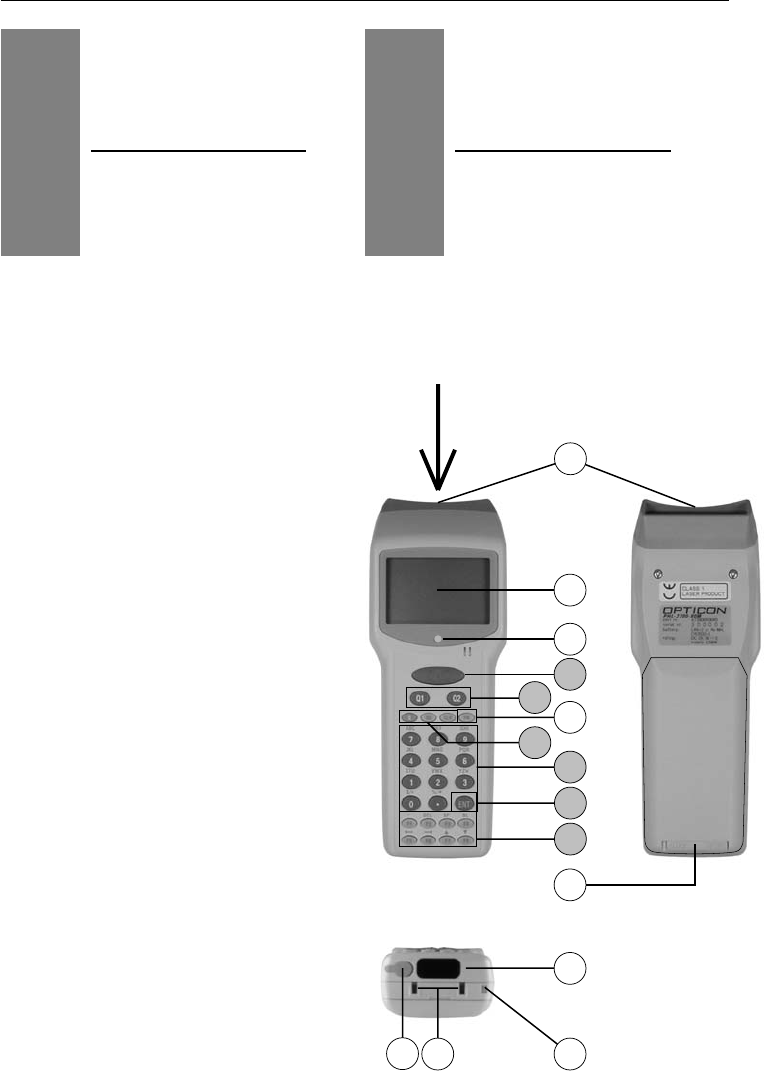
SUPPLEMENT PHL2700 TERMINAL / RF-ID FEATURE
The terminal is a compact, programmable
handheld terminal, and is well suited for a
variety of indoor portable applications. It has a
built-in laser scanner that can scan all popular
bar code labels at varying distances.
In addition, the terminal is equipped with
RF-ID technology and has RF read/write
capability for various types of RF-ID tags.
RF-ID
SUPPLEMENT
INTRODUCTION
1
1
2
3
5
6
4
7
8
9
10
12
11
1314
15
RF-ID
SUPPLEMENT
INSTALLATION
2
2
1. Reading window
- laser beam for barcode reading will be
emitted from here
- antenna for RF-ID reading / writing
is located here
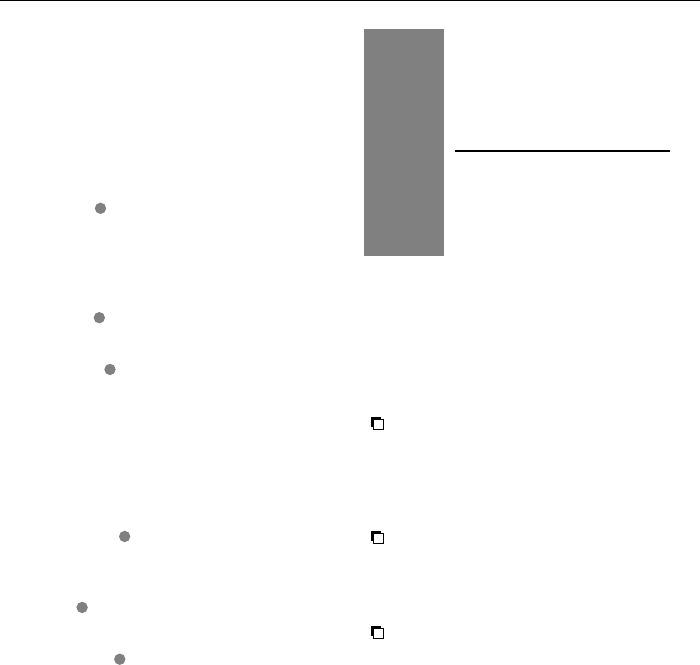
SUPPLEMENT PHL2700 TERMINAL / RF-ID FEATURE
3
The functionality of the terminal is determined
by software, the so-called user application,
that is running on the terminal.
A tool for developing a user application on
the PC for use on the terminal, as supplied
by Opticon is:
C language, consisting of:
- Microtec ANSI-C compiler
- C library for handheld terminals
- RF-ID addon library
Note!
An additional C-library for the PHL2700
with RF-ID feature has been developed,
that needs to be used together with the
C-compiler and C-library for handheld
terminals.
Application Generator Potstar will soon
support Opticon handheld terminals
with RF-ID technology.
(Contact Opticon for availability)
RF-ID
SUPPLEMENT
OPERATION OF
THE TERMINAL
3
2. LCD Display
for displaying information
3. LED indicator
can be used to indicate results, for example
bar code reading / status of communication
4. Power key
for switching power On/Off
5. Trigger key definable by user’s application
typical use: dual read key
- switches laser beam on for barcode reading
- switches RF-ID module on for RF-ID
reading/writing
6. Quick keys definable by user’s application
typical use: menu scroll keys or yes/no input
7. Control keys definable by user’s application
for controlling basic functions
typical use as below:
CLR : Cancel input
BS : Back space
S : Shift key
“S”on the LCD display indicates
the terminal is in the shift mode
8. Character keys definable by user’s application
typical use: for input of alpha-numeric and
punctuation characters
9. ENT key definable by user’s application
typical use: for confirming input
10. Function keys definable by user’s application
user programmable keys, to be used
together with shift key.
typical use as shown on next page
11. Battery case cover
for housing main battery
12. Optical interface window
for infra red communication
13. Hand strap pillar
for attaching hand strap
14. Electrical contacts
for power supply from the cradle IRU2700
to terminal
15. RS-232C connector
for connecting external device, or for system
expansion, through Opticon RS232 cable
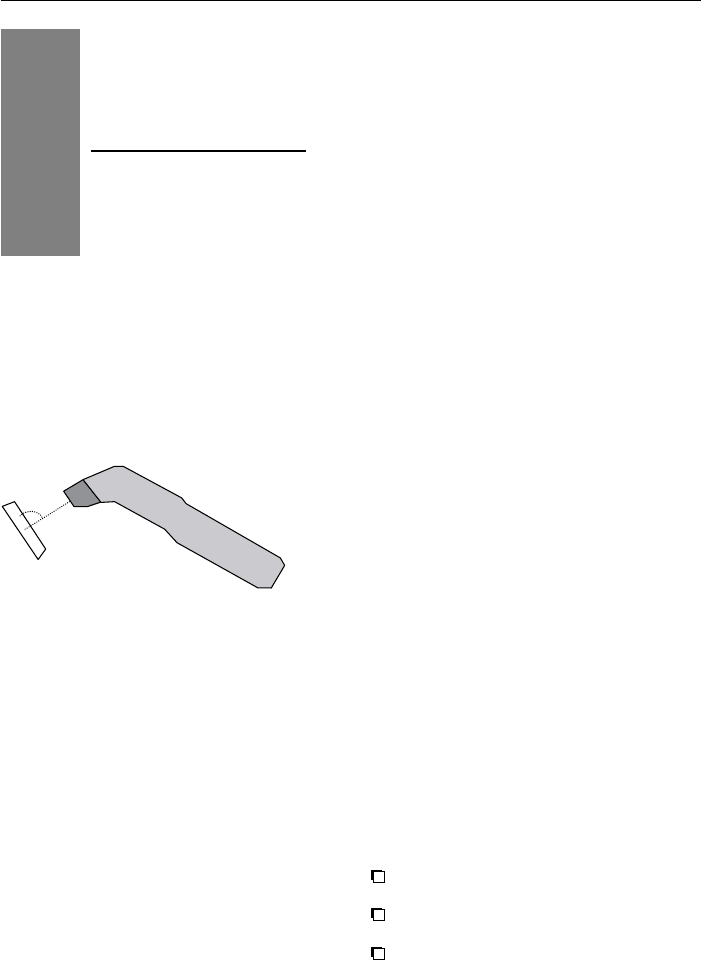
SUPPLEMENT PHL2700 TERMINAL / RF-ID FEATURE
4
RF-ID
SUPPLEMENT
SCANNING
4
Depending on the user application that is
running, the terminal can use the RF-ID
technology for reading a RF-ID tag or for a
combination of reading and writing.
The terminal will detect, read, and write
the RF-ID tag in the way as defined by the
user.
- How to position the terminal
The read direction must be perpendicular
to the plane surface of the tag, as shown in
the scan position illustration.
- How to read the RF-ID tag
Point the nose of the terminal on the tag.
Note that the maximum reading distance
depends on the type of tag.
When a tag is not responding to the
terminal move the nose to another location
of the tag.
- How to write the RF-ID tag
Make sure the tag will not move and hold
the terminal stable for the time that it is
writing. If the tag moves out of the antenna
field before the writing is completed, the
writing operation will fail.
- RF-ID tag reading/writing problems
Reduce the distance between the tag
and the terminal.
Point the terminal to the edge of the
tag.
Make sure there is only one tag in the
reading range.
ca. 90º
scan position
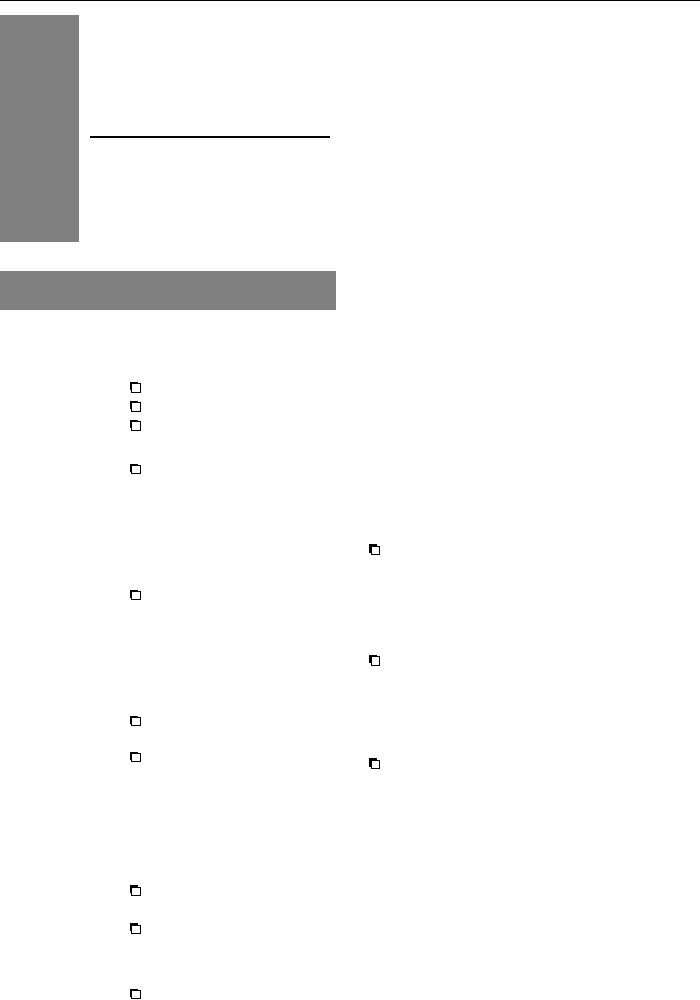
SUPPLEMENT PHL2700 TERMINAL / RF-ID FEATURE
5
6.1.1 Electrical specifications
Main battery rechargeable pack: Ni-MH
dry cell: Alkaline penlite
optional: other 2 x AA-size
penlite
Main battery Ni-MH: When having every 10
operating time seconds on: 1 sec laser,
0.4 sec. green LED, 0.4 sec.
buzzer, 1 sec. RFIDtag reading,
0,2 sec. RFIDtag writing,
operating time is: approx.
22 hours
Alkaline: When having every
10 seconds on: 1 sec laser,
0.4 sec. green LED, 0.4 sec.
buzzer, 1 sec. RFIDtag reading,
0,2 sec. RFIDtag writing,
operating time is: approx.
43 hours
Different operation conditions
affect the operating time
Use of other penlite batteries
affect the operating time
Backup battery Lithium (CR2032)
Backup battery If fully charged: 30 days backup
operating time time
Battery Low voltage indicated on the
management terminal display.
When battery is low the
terminal switches off
automatically.
Charging method Rechargeable Ni-MH pack in
terminal via cradle
RF-ID
SUPPLEMENT
SPECIFICATIONS
6
6.1 SPECIFICATIONS TERMINAL
6.1.5 Environmental specifications
Emission According to EN50081, part 1
Immunity According to EN50082, part 1
R&TTE conform I-ETS 300-330
Additional specifications
Specifications RF-ID module
(RF-ID tag reading)
Reading range up to 15 mm,
dependent on type of RF-ID tag.
Supported RF Tags at 13.56 MHz
Philips I-Code
Texas Instruments Tag-It
ISO 15693
Supported RF Tags at 134.2 kHz
Texas Instruments TIRIS
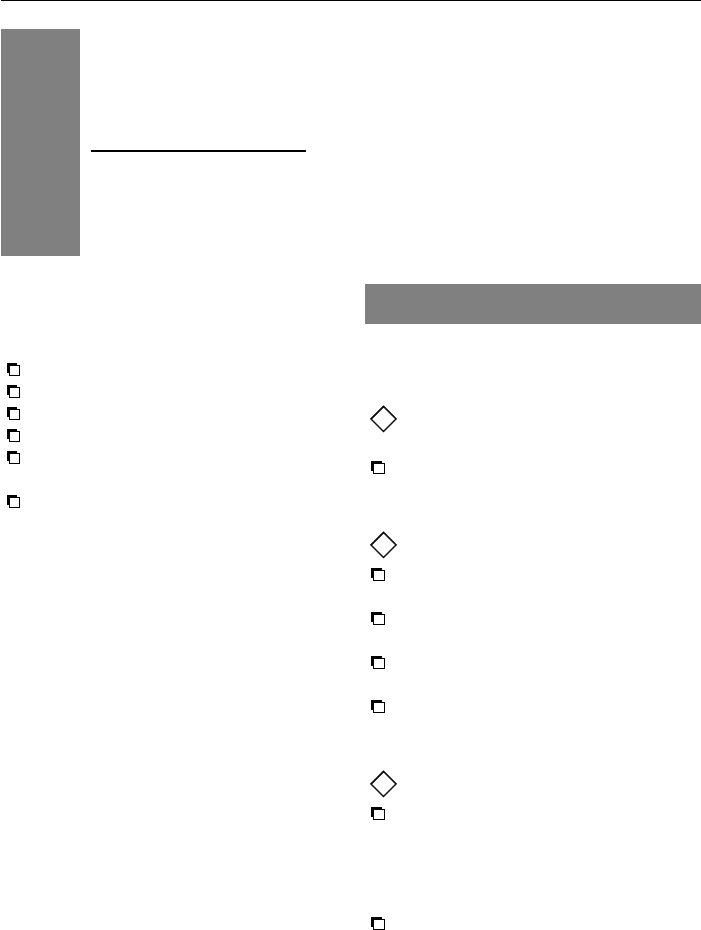
SUPPLEMENT PHL2700 TERMINAL / RF-ID FEATURE
6
RF-ID
SUPPLEMENT
TROUBLE
SHOOTING
7
General checks:
Make sure everything is installed properly
Check the power supply of all devices
Is the reading window of the terminal clean?
Is the optical window of the cradle clean?
Is the RF-ID tag readable,
eg. not damaged?
Has the terminal been configured to
read the type of RF-ID tag? Consult
your application.
When the terminal has a problem with
reading/writing the RF-ID tag:
A metal object is placed direct above
or below the RF-ID tag.
Remove the metal object or move the
tag to an other area.
The RF-ID tag is not read
Decrease the distance between the tag
and the terminal.
Point the terminal to the edge of the
tag.
Make sure there is only one tag in the
reading range.
Place the nose of the terminal in
perpendicular direction with the tag.
The RF-ID tag is not recognized
When using I-code tag, possibly the tag
is in “quiet” mode.
Enable the terminal to send a “reset
quiet mode” command. (consult docu-
mentation of user application)
Check if the type of RF-ID tag is
supported by the user’s application.
If not, enable it. (consult documentation
of user application)
?
?
?
7.2 READ OPERATION
PROBLEMS

SUPPLEMENT PHL2700 TERMINAL / RF-ID FEATURE
7
Article Code
Terminal
PHL 2700-RFID-13.56 A73800R0045
PHL 2700-RFID-134.2 A73800R0110
Software development tools
Microtec
ANSI-C cross compiler O8010000010
C-library for handheld
terminals D4030000020
including addon
PHL2700 - RFID
RF-ID
SUPPLEMENT
ORDERING
INFORMATION
8

SUPPLEMENT PHL2700 TERMINAL / RF-ID FEATURE
8
Opticon Article Code